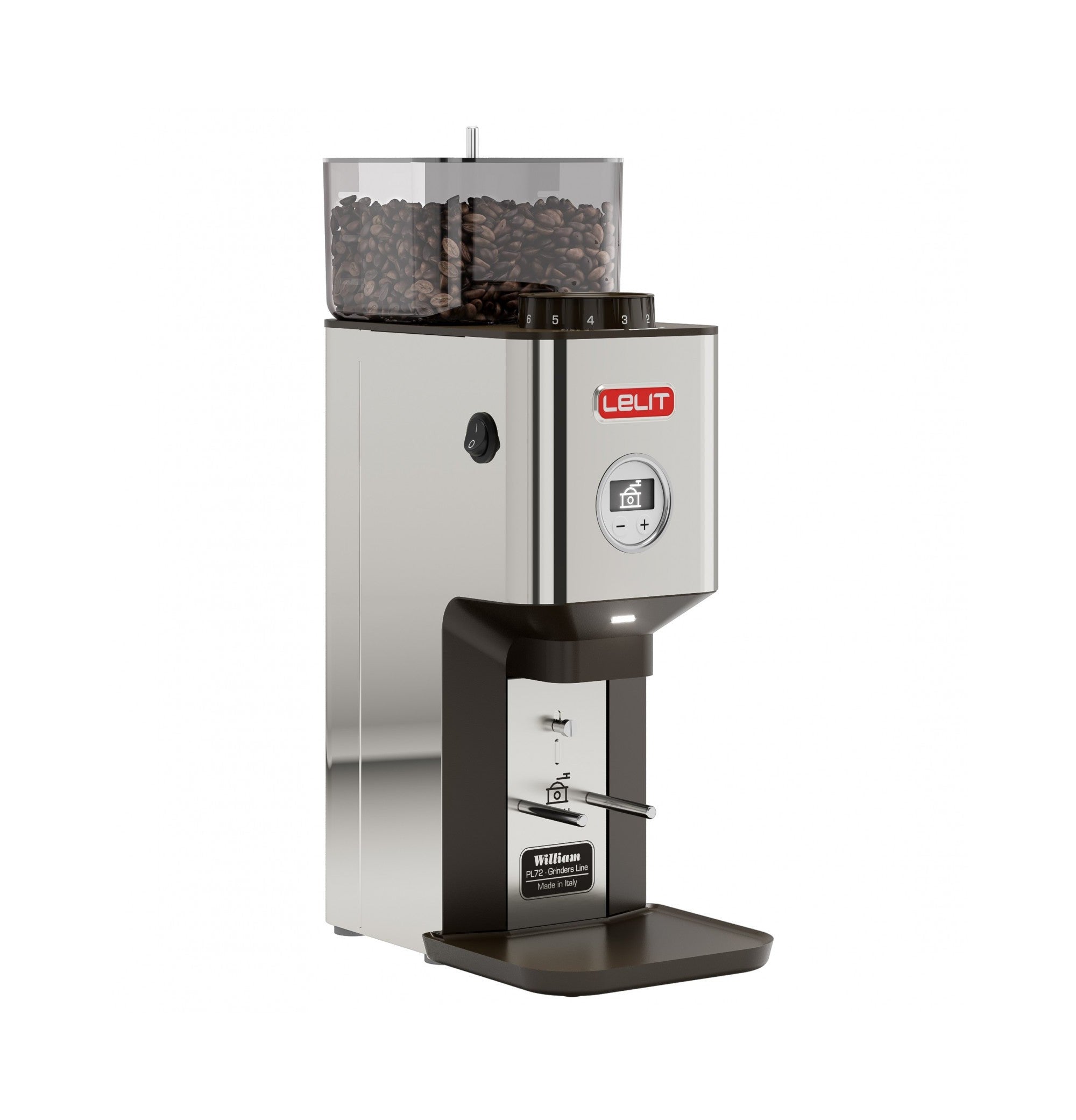
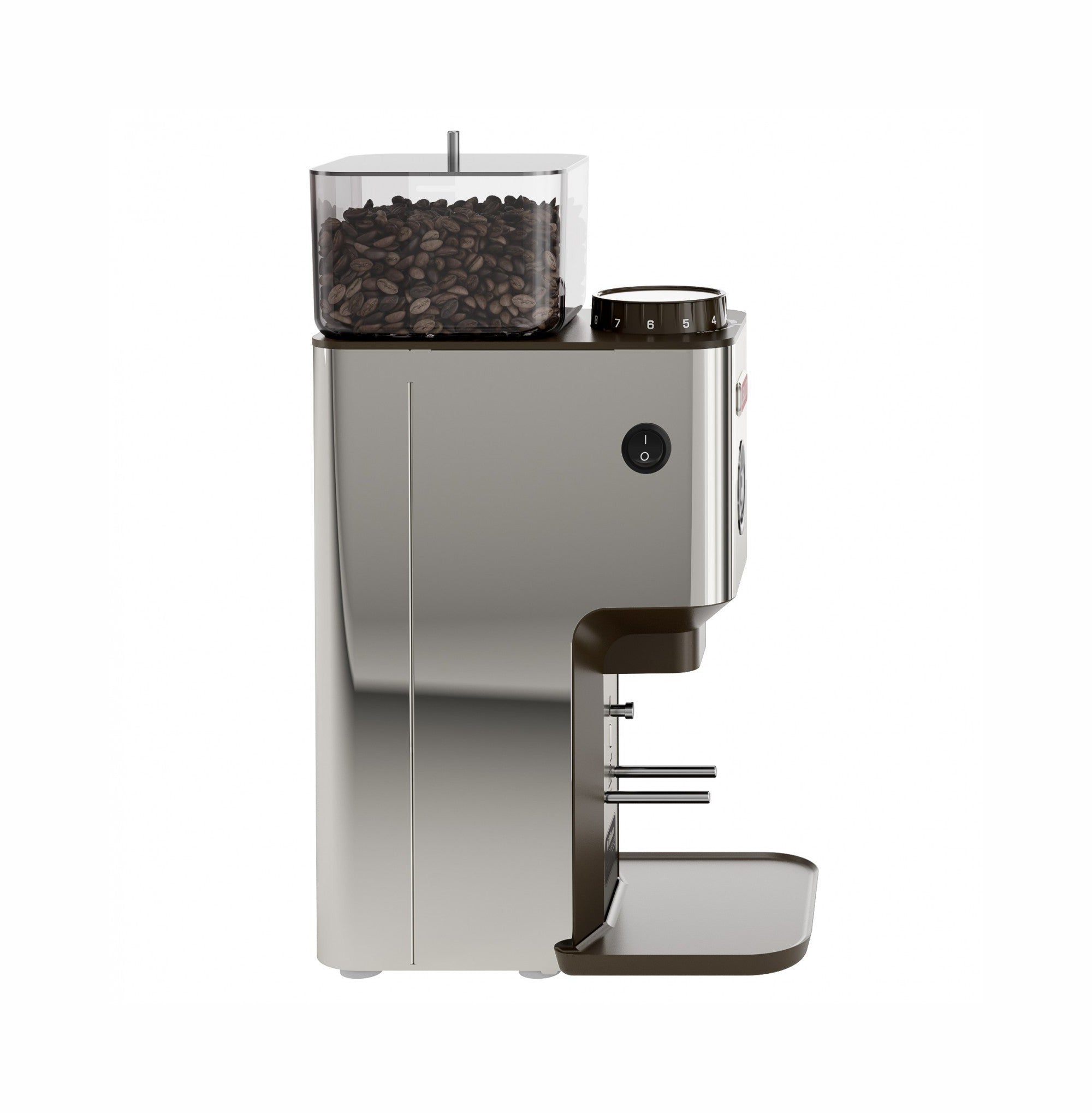
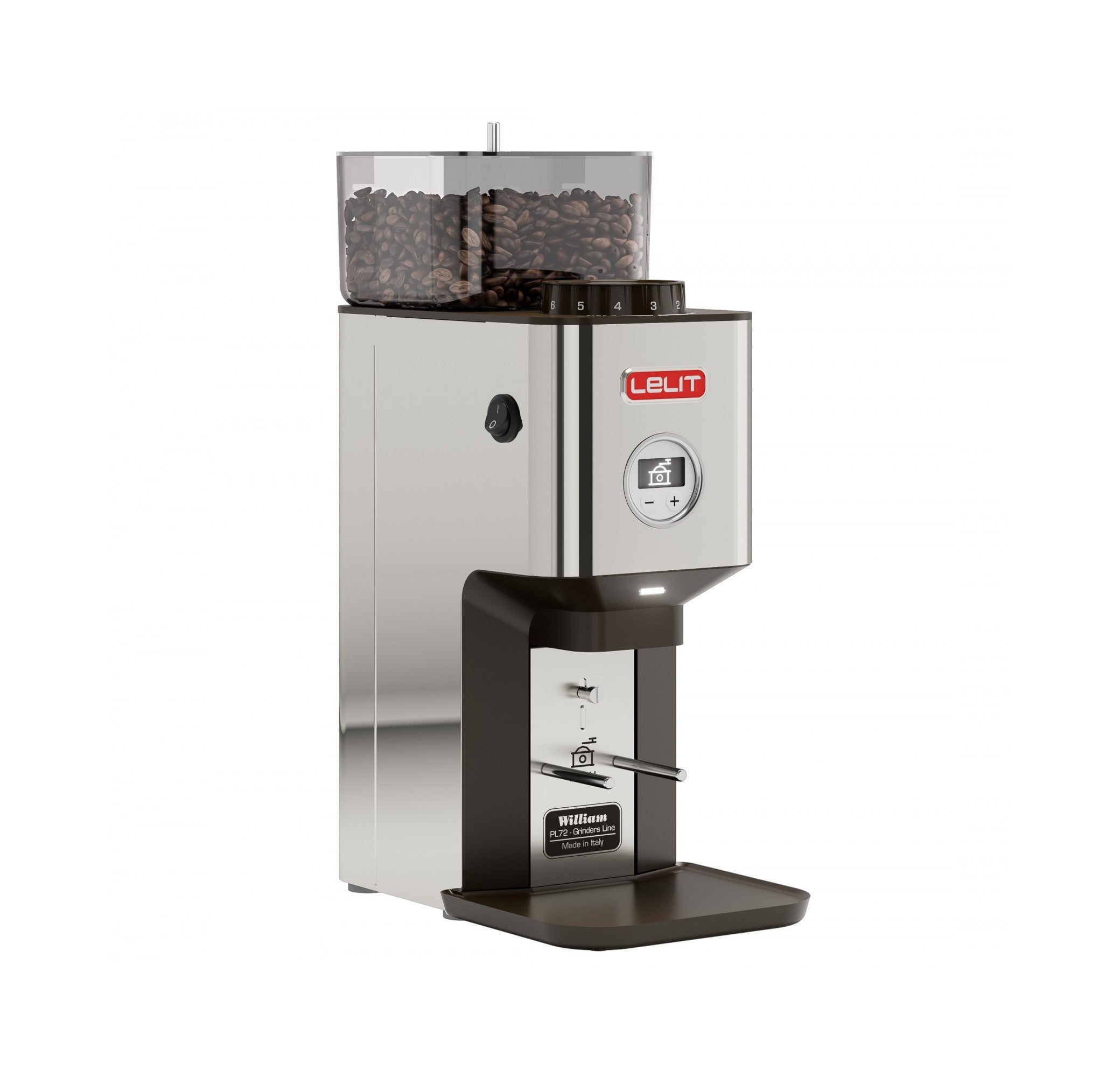
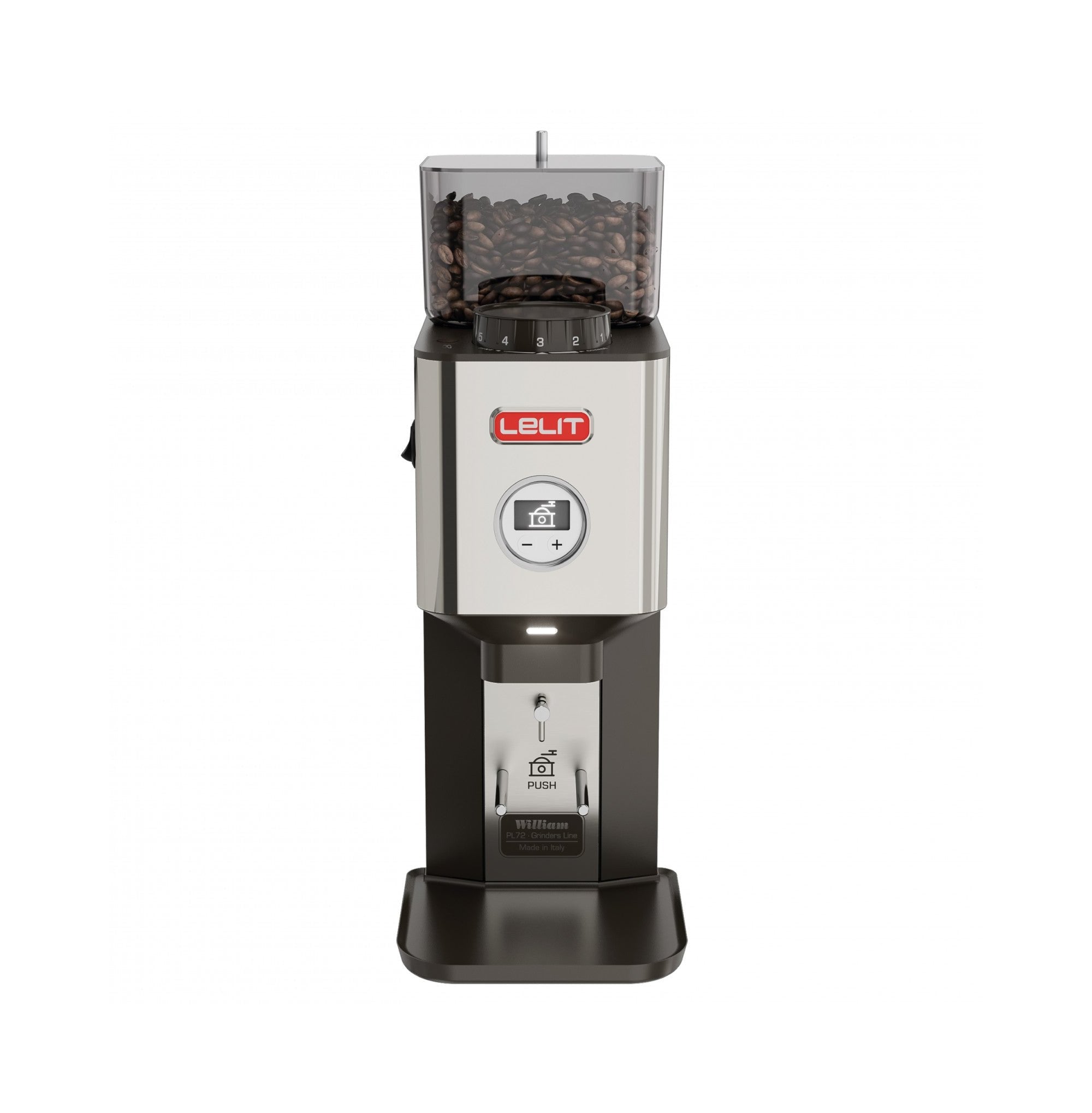
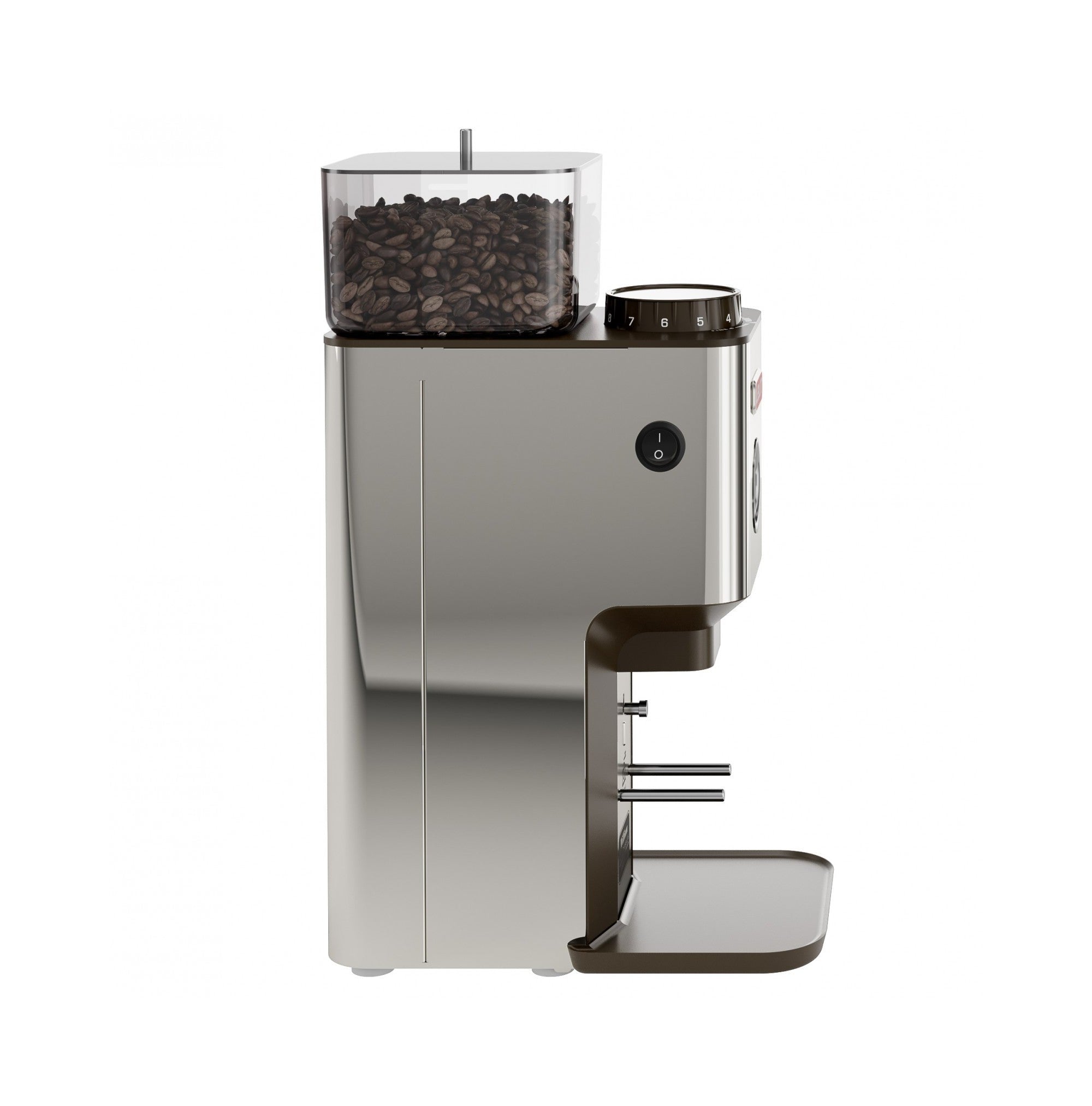
Lelit PL72 and PL72-P William coffee grinder
Incl. IVA
Finanzieren ab 18,95 € / Monat* mit
🚚 Shipping within EU: 8 €
EU shipping costs, see shipping policy.
Passt wunderbar dazu

Lelit PL72 and PL72-P William coffee grinder
Lelit William PL72 - Premium coffee grinder for home baristas
The Lelit William PL72 is a high-quality, semi-professional coffee grinder from Italy - perfect for ambitious coffee and espresso fans. Its timeless stainless steel housing, precise technology and intuitive operation make it the ideal addition to the Lelit VIP line (e.g. Grace, Elizabeth, Victoria).
Highlights of the Lelit PL72:
- Direct grinder with digital timer function
- Flat grinding disks Ø 64 mm made of hardened steel
- Stepless, micrometric grind adjustment
- Powerful motor: 1,390 rpm (150 W)
- Digital LCC display (Lelit Control Center) for programming the grinding time
- Portion counter: individual and total quantities
- Height-adjustable coffee spout
- Hands-free stainless steel holder for portafilter
- Wide drip tray to prevent loss of grounds
- Elegant matt brushed stainless steel housing
Who is the Lelit William suitable for?
The PL72 is ideal for home baristas who value precise grinding, aesthetic design and technical control. Perfect in combination with espresso machines from the Lelit VIP series and a clear recommendation for anyone who wants consistent results with minimal effort.
Technical data at a glance:
- Grinding disks: 64 mm disk grinder made of hardened steel
- Grinder: direct grinder, "on demand"
- Grinding capacity: Espresso: approx. 2.8 g/s - Café Crème: approx. 3 g/s
- Grind adjustment: Micrometric & infinitely variable
- Display: LCC with timer function (1-2 portions)
- Bean container: 350 g, lockable
- Power: 150 W
- Voltage: 230 V / 50 Hz
- Noise level: approx. 72 dB
- Dimensions (W × D × H): 14 × 22.5 × 38.5 cm
- Weight: 6.6 kg
Design & workmanship:
The housing of the PL72 is made of matt brushed stainless steel and black plastic. It impresses with its robust workmanship, compact design and elegant lines - ideal for any style-conscious kitchen.
Scope of delivery:
- Lelit William PL72 coffee grinder
- Hands-free portafilter holder (integrated)
- 350 g bean container (transparent, lockable)
- Large drip tray
- Operating instructions
Note on quality:
As Lelit tests every grinder under real conditions before delivery, there may still be a small amount of coffee residue in the grinder on delivery - a sign of genuine quality control.
Conclusion:
The Lelit PL72 William is a real insider tip for discerning coffee lovers. It combines professional-level technology with an elegant appearance and convenient operation - perfect for your private espresso bar.
Información sobre el fabricante
* Bonität vorausgesetzt. Ratenbeispiel für PayPal Ratenzahlung: effektiver Jahreszins 12,49 % p.a., fester Sollzinssatz 11,80 % p.a., Laufzeit 24 Monate. Genaue Konditionen und Gesamtkosten werden im nächsten Schritt von PayPal angezeigt. Angebot gültig nur für Kunden mit Wohnsitz in Deutschland. Weitere Infos zur Bonitätsprüfung.
If you have any questions, please feel free to contact us at any time. We will get back to you as soon as possible, within 24 hours on weekdays.
-
Shipping info
We ship all products the same day if ordered before 1pm.
-
Soporte
We will also be there to support you and advise you after your purchase. If you have any questions about the product you purchased from us, please contact us.
-
Contact
Email: hello@naturbohne.de
Teléfono: 07454 / 870 48 64
Frequently Asked Questions
I bought a new coffee grinder from Naturbohne and there are coffee residues in it.
Please note: Some manufacturers test their coffee grinders before shipping, which means that small coffee residues or bean residues can occasionally be found in the grinder. This procedure is used to test functionality and is considered a quality feature. Of course, we only sell new products - unless expressly stated otherwise.
Static charge – coffee grounds spray out from the side
With some coffee grinders, the ground coffee can become statically charged and spray out of the portafilter at the side. This means that not all of the ground coffee gets into the portafilter, which can lead to uneven extraction. Our recommendation: Use a dosing funnel to ensure that all of the ground coffee is precisely fed into the portafilter - for optimal espresso enjoyment.
What is dead space in coffee grinders?
Conventional coffee grinders often leave a so-called dead space in which coffee residues accumulate. These residues can not only affect the freshness, but also lead to old and fresh coffee grounds being mixed, which negatively affects the taste. In contrast, single dose grinders have a well-thought-out design that eliminates the dead space. Each portion is ground individually and precisely so that no residues are left behind - for a consistently pure and full-bodied coffee experience.
Which portafilter fits my espresso machine?
When choosing the right portafilter for your portafilter machine, it is important to know that each manufacturer develops its own brewing group - the most well-known is the Faema E61. However, this does not mean that any portafilter will fit without any problems. An incompatible portafilter can leak, which will have a direct negative impact on the quality of your espresso. We therefore recommend using either the portafilter originally supplied or one that is explicitly stated to be compatible with your machine. This will ensure that the pressure is optimally built up and the espresso is perfectly extracted.
Can I visit you or pick up the goods personally?
Yes, of course, you are welcome to come by and look at our products by appointment. We would be happy to advise you personally. The best thing to do is to send us an email with a few suggested appointment times.
We are located 5 minutes from the motorway between Stuttgart and Lake Constance on the edge of the Black Forest.
Important note, first use coffee grinders
Another little tip for the perfect start with your new mill:
You will get the best grinding result after you have ground about 1-2 kg of beans. It is best to use a few cheap beans so that the grinder can work optimally. And if you are wondering what you can do with the bean flour - it is perfect plant fertilizer! 🌿
It contains nitrogen, potassium, sulfur and phosphorus and is a real nutrient bomb for your plants.
¿Pueden realizar una calibración de offset en mi máquina de portafiltro?
Existen varios argumentos en contra de una calibración de compensación en las máquinas de portafiltro Lelit, especialmente en modelos como la Lelit Bianca. Estos se refieren principalmente a la complejidad y las limitaciones de la compensación como única solución para problemas de temperatura:
- Fluctuaciones de temperatura e inestabilidad. La compensación considera una diferencia constante entre la temperatura de la caldera y la temperatura de preparación. Sin embargo, en la práctica pueden ocurrir fluctuaciones de temperatura, por ejemplo, debido a tiempos de espera prolongados o preparación continua. Esto hace que la temperatura de preparación real no siempre sea predecible con precisión.
- Dependencia de las condiciones ambientales. Factores como la temperatura ambiente, la humedad y el estado de la máquina (por ejemplo, el tiempo de calentamiento) afectan significativamente la temperatura de preparación. Una compensación fija no puede equilibrar dinámicamente estas variables, lo que puede llevar a resultados inexactos.
- Pérdida de calor durante los tiempos de espera. Después de pausas prolongadas, el grupo de preparación se enfría y la máquina necesita tiempo para volver a la temperatura deseada. Una compensación correctamente ajustada no puede compensar esto, por lo que son necesarias medidas adicionales como un "Cooling Flush".
- Desajustes de fábrica. En algunos modelos de Lelit se ha encontrado que la compensación de fábrica a menudo está configurada de manera inexacta (por ejemplo, de 4 a 8 grados demasiado baja en la Lelit Bianca). Esto requiere una recalibración manual por parte de personal especializado, lo cual puede ser complicado para los usuarios finales.
- Malentendidos en la aplicación. Muchos usuarios están confundidos por la información contradictoria sobre la configuración de la compensación, lo que puede llevar a ajustes incorrectos. Por ejemplo, a menudo se espera que la compensación por sí sola resuelva todos los problemas de temperatura, aunque solo es parte de un sistema más complejo.
Conclusión
La calibración de compensación es una herramienta útil, pero no debe considerarse de forma aislada. Una combinación de control PID preciso, mantenimiento regular y técnicas adaptadas (por ejemplo, "spülshots") es necesaria para lograr resultados óptimos de preparación.
Do you have any more questions?
Contact
If you have any questions about our products, please write to us here or use the chat function.